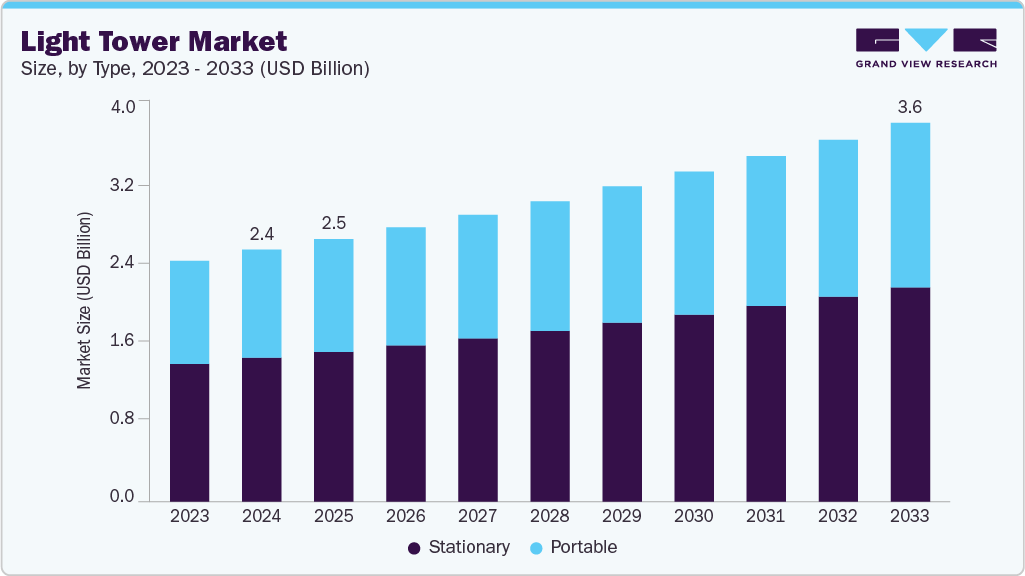Light Tower Market 2033: Navigating the Future of Urban Lighting
The global light tower market was valued at USD 2,393.3 million in 2024 and is expected to grow to USD 3,597.3 million by 2033.
The global light tower market was valued at USD 2,393.3 million in 2024 and is expected to grow to USD 3,597.3 million by 2033, expanding at a CAGR of 4.7% from 2025 to 2033. The primary driver of this growth is the rising construction and infrastructure development worldwide.
Increasing urbanization combined with significant government investments in public infrastructure projects has boosted demand for portable lighting solutions. Additionally, the growth of mining and oil & gas operations in remote locations further propels the need for efficient lighting systems. These sectors often operate in challenging environments where fixed lighting solutions are impractical, making mobile light towers indispensable. The focus on worker safety and the need for continuous operations also supports market expansion. Furthermore, advancements in LED and solar technologies are improving energy efficiency and lowering operating costs.

Key Market Trends & Insights
- Regional Dominance: Asia Pacific holds the largest market share at 42.4% in 2024. This dominance is driven by extensive development activities, including transportation infrastructure, mining, and urban expansion in countries like China and India. The region’s rapid growth is supported by the adoption of flexible and mobile lighting technologies tailored for dynamic job sites. Affordability and technological innovation are key factors sustaining this growth.
- Power Source: Fossil fuel-powered light towers led the market with a 53.8% revenue share in 2024. Their popularity stems from their high power output and reliability, especially in remote locations without grid access. These towers are widely used in construction, mining, and oil & gas industries, preferred for their long runtimes and durability in heavy-duty, large-scale projects.
- Type: Stationary light towers accounted for the largest market share of 57.1% in 2024. These towers are widely used in long-term and large-scale industrial or infrastructure projects, offering high power capacity and continuous operation. Their robustness and suitability for fixed-site operations such as construction zones and mining fields make them the preferred option in demanding environments.
- Lifting Method: Hydraulic lifting systems dominated the market with a 63.0% share in 2024. These systems provide convenience, safety, and efficiency by enabling quick and effortless mast extension, significantly reducing setup time and labor. Hydraulic towers are favored in heavy-duty operations within mining, oil & gas, and infrastructure projects, with increasing adoption due to automation trends and safety considerations.
- Lamp Type: LED lamps led the market with a 57.5% share in 2024. Their superior energy efficiency, longer lifespan, and low maintenance requirements make them highly desirable. LED towers provide instant illumination, durability, and lower operating costs compared to traditional lamps. Growing environmental concerns and falling LED prices are accelerating their adoption across industries.
- End Use: The construction sector led with a 40.8% share in 2024. Construction projects often require reliable lighting for nighttime work or operations in remote locations to ensure safety and productivity. Light towers are essential for road building, infrastructure development, and other construction activities. Ongoing urbanization and government infrastructure spending continue to drive demand in this segment.
Order a free sample PDF of the Light Tower Market Intelligence Study, published by Grand View Research.
Market Size & Forecast
- 2024 Market Size: USD 2,393.3 Million
- 2033 Projected Market Size: USD 3,597.3 Million
- CAGR (2025-2033): 4.7%
- Asia Pacific: Largest market in 2024
Key Companies & Market Share Insights
Notable players in the light tower market include Allmand Bros., Inc., PowerLink, and Mitsubishi Heavy Industries, Ltd.
- Allmand Bros., Inc. specializes in heavy-duty light towers designed for construction, mining, and oilfield applications. Their product lineup features advanced LED lighting, long fuel runtimes, and rugged designs for extreme environments. The company also produces mobile generators and portable heaters, offering comprehensive site power and climate control solutions. They incorporate telematics for remote equipment monitoring and provide extensive aftermarket support across North America.
- PowerLink offers a wide range of energy solutions including light towers, diesel and gas generators, hybrid energy systems, and acoustic enclosures. Their light towers are used in telecom, construction, and disaster recovery sectors, with solar and hybrid options available for fuel savings and environmental compliance. PowerLink emphasizes modular designs and remote control features to improve operational efficiency, serving customers globally with manufacturing and service centers in the UK, China, and the Middle East.
Key Players
- Allmand Bros., Inc.
- PowerLink
- MITSUBISHI HEAVY INDUSTRIES, LTD.
- Atlas Copco
- Caterpillar.
- Sigma Search Lights Limited
- Chicago Pneumatic
- Doosan Bobcat.
- Generac Power Systems, Inc.
- HIMOINSA
- Progress Solar Solutions
- Maxar Technologies
- The Will Burt Company
- TRIME s.r.l.
- PR Industrial Srl Unipersonale
- Wacker Neuson SE
Explore Horizon Databook – The world's most expansive market intelligence platform developed by Grand View Research.
Conclusion
The global light tower market is poised for steady growth, driven by expanding construction and infrastructure projects, particularly in emerging economies within Asia Pacific. The persistent need for portable and reliable lighting solutions in challenging and remote environments is fueling demand. Technological advancements in LED lighting, hydraulic systems, and fuel efficiency are improving product performance and lowering operational costs, further supporting market expansion. With key players innovating and expanding their product portfolios, the light tower market is well-positioned to meet the evolving needs of diverse industries through 2033.